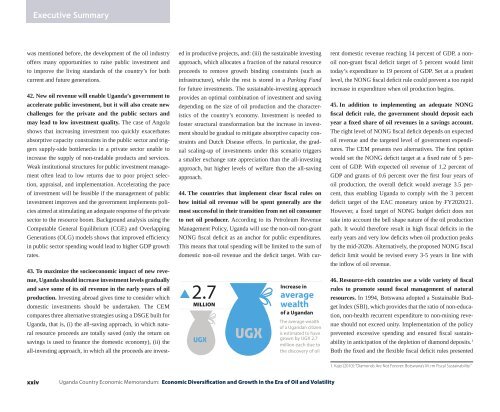Economic Diversification and Growth
71mK301zeG0
71mK301zeG0
You also want an ePaper? Increase the reach of your titles
YUMPU automatically turns print PDFs into web optimized ePapers that Google loves.
Executive Summary<br />
was mentioned before, the development of the oil industry<br />
offers many opportunities to raise public investment <strong>and</strong><br />
to improve the living st<strong>and</strong>ards of the country’s for both<br />
current <strong>and</strong> future generations.<br />
42. New oil revenue will enable Ug<strong>and</strong>a’s government to<br />
accelerate public investment, but it will also create new<br />
challenges for the private <strong>and</strong> the public sectors <strong>and</strong><br />
may lead to low investment quality. The case of Angola<br />
shows that increasing investment too quickly exacerbates<br />
absorptive capacity constraints in the public sector <strong>and</strong> triggers<br />
supply-side bottlenecks in a private sector unable to<br />
increase the supply of non-tradable products <strong>and</strong> services.<br />
Weak institutional structures for public investment management<br />
often lead to low returns due to poor project selection,<br />
appraisal, <strong>and</strong> implementation. Accelerating the pace<br />
of investment will be feasible if the management of public<br />
investment improves <strong>and</strong> the government implements policies<br />
aimed at stimulating an adequate response of the private<br />
sector to the resource boom. Background analysis using the<br />
Computable General Equilibrium (CGE) <strong>and</strong> Overlapping<br />
Generations (OLG) models shows that improved efficiency<br />
in public sector spending would lead to higher GDP growth<br />
rates.<br />
43. To maximize the socioeconomic impact of new revenue,<br />
Ug<strong>and</strong>a should increase investment levels gradually<br />
<strong>and</strong> save some of its oil revenue in the early years of oil<br />
production. Investing abroad gives time to consider which<br />
domestic investments should be undertaken. The CEM<br />
compares three alternative strategies using a DSGE built for<br />
Ug<strong>and</strong>a, that is, (i) the all-saving approach, in which natural<br />
resource proceeds are totally saved (only the return on<br />
savings is used to finance the domestic economy), (ii) the<br />
all-investing approach, in which all the proceeds are invested<br />
in productive projects, <strong>and</strong>: (iii) the sustainable investing<br />
approach, which allocates a fraction of the natural resource<br />
proceeds to remove growth binding constraints (such as<br />
infrastructure), while the rest is stored in a Parking Fund<br />
for future investments. The sustainable-investing approach<br />
provides an optimal combination of investment <strong>and</strong> saving<br />
depending on the size of oil production <strong>and</strong> the characteristics<br />
of the country’s economy. Investment is needed to<br />
foster structural transformation but the increase in investment<br />
should be gradual to mitigate absorptive capacity constraints<br />
<strong>and</strong> Dutch Disease effects. In particular, the gradual<br />
scaling-up of investments under this scenario triggers<br />
a smaller exchange rate appreciation than the all-investing<br />
approach, but higher levels of welfare than the all-saving<br />
approach.<br />
grown by UGX 2.7<br />
million each due to<br />
the discovery of oil<br />
44. The countries that implement clear fiscal rules on<br />
how initial oil revenue will be spent generally are the<br />
most successful in their transition from net oil consumer<br />
to net oil producer. According to its Petroleum Revenue<br />
Management Policy, Ug<strong>and</strong>a will use the non-oil non-grant<br />
NONG fiscal deficit as an anchor for public expenditures.<br />
This means that total spending will be limited to the sum of<br />
domestic non-oil revenue <strong>and</strong> the deficit target. With current<br />
domestic revenue reaching 14 percent of GDP, a nonoil<br />
non-grant fiscal deficit target of 5 percent would limit<br />
today’s expenditure to 19 percent of GDP. Set at a prudent<br />
level, the NONG fiscal deficit rule could prevent a too rapid<br />
increase in expenditure when oil production begins.<br />
45. In addition to implementing an adequate NONG<br />
fiscal deficit rule, the government should deposit each<br />
year a fixed share of oil revenues in a savings account.<br />
The right level of NONG fiscal deficit depends on expected<br />
oil revenue <strong>and</strong> the targeted level of government expenditures.<br />
The CEM presents two alternatives. The first option<br />
would set the NONG deficit target at a fixed rate of 5 percent<br />
of GDP. With expected oil revenue of 1.2 percent of<br />
GDP <strong>and</strong> grants of 0.6 percent over the first four years of<br />
oil production, the overall deficit would average 3.5 percent,<br />
thus enabling Ug<strong>and</strong>a to comply with the 3 percent<br />
deficit target of the EAC monetary union by FY2020/21.<br />
However, a fixed target of NONG budget deficit does not<br />
take into account the bell shape nature of the oil production<br />
path. It would therefore result in high fiscal deficits in the<br />
early years <strong>and</strong> very low deficits when oil production peaks<br />
by the mid-2020s. Alternatively, the proposed NONG fiscal<br />
deficit limit would be revised every 3-5 years in line with<br />
the inflow of oil revenue.<br />
46. Resource-rich countries use a wide variety of fiscal<br />
rules to promote sound fiscal management of natural<br />
resources. In 1994, Botswana adopted a Sustainable Budget<br />
Index (SBI), which provides that the ratio of non-education,<br />
non-health recurrent expenditure to non-mining revenue<br />
should not exceed unity. Implementation of the policy<br />
prevented excessive spending <strong>and</strong> ensured fiscal sustainability<br />
in anticipation of the depletion of diamond deposits. 1<br />
Both the fixed <strong>and</strong> the flexible fiscal deficit rules presented<br />
1. Kajo (2010): “Diamonds Are Not Forever: Botswana’s M. rm Fiscal Sustainability”<br />
xxiv<br />
Ug<strong>and</strong>a Country <strong>Economic</strong> Memor<strong>and</strong>um: <strong>Economic</strong> <strong>Diversification</strong> <strong>and</strong> <strong>Growth</strong> in the Era of Oil <strong>and</strong> Volatility


